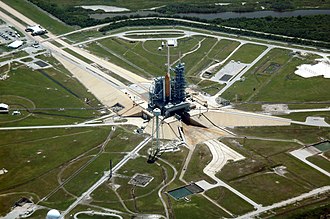Launch pad
This article has multiple issues. Please help improve it or discuss these issues on the talk page. (Learn how and when to remove these template messages)
|

| Part of a series on |
| Spaceflight |
|---|
 |
|
|
A launch pad is an above-ground facility from which a
Most launch pads include fixed service structures to provide one or more access platforms to assemble, inspect, and maintain the vehicle and to allow access to the spacecraft, including the loading of crew. The pad may contain a flame deflection structure to prevent the intense heat of the rocket exhaust from damaging the vehicle or pad structures, and a sound suppression system spraying large quantities of water may be employed. The pad may also be protected by lightning arresters. A spaceport typically includes multiple launch complexes and other supporting infrastructure.
A launch pad is distinct from a missile launch facility (or missile silo or missile complex), which also launches a missile vertically but is located underground in order to help harden it against enemy attack.
The launch complex for liquid fueled rockets often has extensive
Most rockets need to be supported and held down for a few seconds after ignition while the engines build up to full
Transport of rockets to the pad
This section possibly contains original research. (November 2018) |

.
Each launch site is unique, but a few broad types can be described by the means by which the space vehicle gets to the pad.[citation needed]
- Horizontally integrated rockets travel horizontally with the tail forward to the launch site on a Electronlaunch vehicles.
- Silo launched rockets are assembled inside of a missile silo. This method is only used by converted ICBMs due to the difficulty and expense of constructing a silo that can contain the forces of a rocket launch.
- Vertically integrated rockets can be assembled in a separate Launch Complex 39 at the Kennedy Space Center is an example of a facility using this method.[2] A similar system is used to launch Ariane 5 rockets at ELA-3 at Guiana Space Centre.
- Vertically assembled vehicles can also be transported on a mobile launcher platform resting on two parallel standard gauge railroad tracks that run from the integration building to launch area. This system is still in use for the Vulcan.
- At Kagoshima for the M-V.
- The former floating launch platform into geostationary transfer orbits.
See also
- Ground segment – Ground-based elements of a spacecraft system
- Launch vehicle – Rocket used to carry a spacecraft into space
- List of rocket launch sites
- Missile launch facility
- Non-rocket spacelaunch
- Pad abort test – test of a spacecraft's launch abort system
- Rocket launch
- Service structure – Structure built on a rocket launch pad to service launch vehicles
- Spaceport
- Stratolaunch Systems – American space transportation venture
- Transporter erector launcher – Self-propelled heavy missile systems
References
- ISBN 9780850451634.
- ^ "LAUNCH COMPLEX 39, PADS A AND B". NASA KSC. 1992. Archived from the original on 2008-09-21.
- ^ "Cpsb Launchpad". Viswanath. 2023. Archived from the original on 2023-06-16. Retrieved 2023-06-16.
